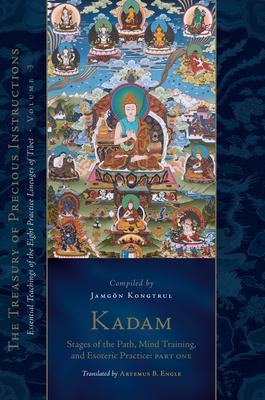
Book
Kadam: Stages of the Path, Mind Training, and Esoteric Practice, Part One: Essential Teachings of the Eight Practice Lineages of Tibet, Volume 3 (the
(Write a Review)
Hardcover
$54.95
The Kadam lineage derives from the teachings and practices taught by the Indian master Atiśa and his Tibetan students. Atiśa spent twelve years in Tibet and left a scholarly and devotional lineage that would be significant to all traditions of Tibetan Buddhism, but particularly the Geluk, the tradition of the Dalai Lamas, which fashioned themselves as the New Kadam tradition.
Jamgn Kongtrul's catalog to The Treasury of Precious Instructions classifies Kadam literature into five categories: treatise, instruction, esoteric practice, ancillary works, and associated works. The first two are the main topics covered in this volume: Lamrim, or Stages of the Path, and Lojong, or Mind Training. These two Kadam teachings continue to exert a significant influence on Tibetan Buddhism and therefore represent the legacy of the Kadam tradition.
The first centers around "The Lamp for the Path to Enlightenment," written by the eleventh-century Indian master Atiśa who spent twelve years in Tibet, and this volume also includes stories of Atiśa's life and travels. The second set of teachings consists of aphorisms known as the Seven-Point Mind Training, meant to be used as contemplative practices to develop compassion and transform the mind. These selections show not only the foundational texts of the Kadam tradition but also the widespread impact these teachings continued to have across traditions.
The Kadam lineage derives from the teachings and practices taught by the Indian master Atiśa and his Tibetan students. Atiśa spent twelve years in Tibet and left a scholarly and devotional lineage that would be significant to all traditions of Tibetan Buddhism, but particularly the Geluk, the tradition of the Dalai Lamas, which fashioned themselves as the New Kadam tradition.
Jamgn Kongtrul's catalog to The Treasury of Precious Instructions classifies Kadam literature into five categories: treatise, instruction, esoteric practice, ancillary works, and associated works. The first two are the main topics covered in this volume: Lamrim, or Stages of the Path, and Lojong, or Mind Training. These two Kadam teachings continue to exert a significant influence on Tibetan Buddhism and therefore represent the legacy of the Kadam tradition.
The first centers around "The Lamp for the Path to Enlightenment," written by the eleventh-century Indian master Atiśa who spent twelve years in Tibet, and this volume also includes stories of Atiśa's life and travels. The second set of teachings consists of aphorisms known as the Seven-Point Mind Training, meant to be used as contemplative practices to develop compassion and transform the mind. These selections show not only the foundational texts of the Kadam tradition but also the widespread impact these teachings continued to have across traditions.
Hardcover
$54.95